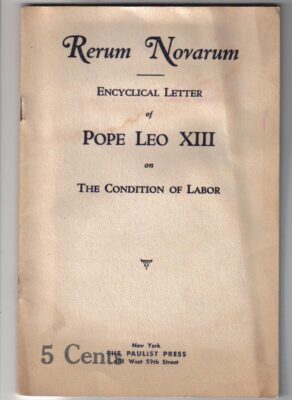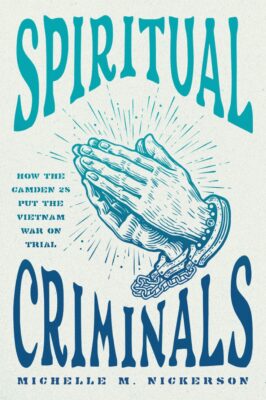Editor's Note
Post #3 in an ongoing series related to Michelle Nickerson’s Spiritual Criminals.
Last week’s discussion of Michelle Nickerson’s Spiritual Criminals focused on a concrete historical character: Cardinal Francis Spellman. This week I want go larger. An animating theme in the book is something called “Catholic Social Teaching”—or “CST” for short.[1] This theme touches every historical activist and actor in Spiritual Criminals. Beyond the book, because CST is an essential aspect of the faith in modern times, Catholics everywhere must reckon with the implications of it in their lives. Catholic Social Teaching is part of the spine of Nickerson’s story about the Camden 28.
By ‘modern times’ I mean—and I think the Catholic Church means—since the late nineteenth century and the advent of various aspects of “mass society.” Catholics felt compelled to respond to “the social question” that this kind of society raised. For Nickerson, the concern is how CST affected the forerunners and direct actors in the Camden 28. This means assessing CST in its American context during the Cold War and through the Vietnam War.
In Catholicism generally, the CST can be seen as stretching back to the Sermon on the Mount. The deepest written roots, then, are the New Testament, the “Hebrew Bible” (an older Catholic term), and the so-called “Church Fathers” (Apostolic and Patristic)—all links are to the online version of the 1913 Catholic Encyclopedia. Sometimes a few Medieval thinkers are included in the CST, especially Thomas Aquinas for his building on Aristotle’s (and Plato’s) idea of “the common good.”

This is Paulist Press edition of Rerum Novarum (1891)
In her story about Catholic Social Teaching, Nickerson takes us back to Pope Leo XIII’s 1891 encyclical, Rerum Novarum (pp. 9, 34 of her text, document at this link, and the Catholic Encyclopedia summary at this one). The first paragraph of Rerum Novarum lays out the larger social, national, and international concerns—ones that would lurk in the background of Camden 28 activists against the Vietnam War (italics mine):
“That the spirit of revolutionary change, which has long been disturbing the nations of the world, should have passed beyond the sphere of politics and made its influence felt in the cognate sphere of practical economics is not surprising. The elements of the conflict now raging are unmistakable, in the vast expansion of industrial pursuits and the marvellous discoveries of science; in the changed relations between masters and workmen; in the enormous fortunes of some few individuals, and the utter poverty of the masses; the increased self reliance and closer mutual combination of the working classes; as also, finally, in the prevailing moral degeneracy. The momentous gravity of the state of things now obtaining fills every mind with painful apprehension; wise men are discussing it; practical men are proposing schemes; popular meetings, legislatures, and rulers of nations are all busied with it – actually there is no question which has taken deeper hold on the public mind.”
The engines of CST, then, are revolutionary changes politics, economics, industry, science, social classes (or inequality), and moral norms. These changes result in apprehension, questions, and corrective schemes.
Economics is central to Rerum Novarum. The encyclical sets out to define and discuss the “relative rights and mutual duties of the rich and of the poor, of capital and of labor.” The term ‘capital’ is mentioned only five times in the encyclical, but the notion of ‘capitalism’ looms large in the background. The letter affirms private property, but also rights, justice, and equality, as well as the contribution of all to the common good. The right of workers to form labor unions and mutual associations is affirmed. The notion of a ‘working class’ is acknowledged. In the last few paragraphs, Pope Leo XIII states the following:
“At the time being, the condition of the working classes is the pressing question of the hour, and nothing can be of higher interest to all classes of the State than that it should be rightly and reasonably settled. But it will be easy for Christian working men to solve it aright if they will form associations, choose wise guides, and follow on the path which with so much advantage to themselves and the common weal was trodden by their fathers before them.”
It took some time for the concerns of Rerum Novarum to take root in the United States. Some decades later, in the 1930s and in the midst of the Great Depression, these questions found partial answers in Catholic Worker houses. Nickerson covers this topic in Spiritual Criminals. Those were begun by Peter Maurin and Dorothy Day. In addition to providing some refuge for the unemployed, Catholic Worker houses also had an intellectual life. Enthusiasts and regulars could participate round table conversations and simple supper discussions about social questions (p. 9, 32). For Day, this was an extension of her pre-Catholic conversion work that centered on labor questions. During World War II, however, she also took a principled stand for nonviolence, peace, pacifism, and conscientious objections to military service (p. 32). The Catholic Worker Movement, then, proved instrumental in showing Catholics how to live out Rerum Novarum.
Nickerson relays that Catholic Workers inspired 1960s Catholic Leftists. They were also motivated by the example and writings of Martin Luther King, Jr. They shared “a vision of economic and racial justice as well as world peace” that, like Catholic Social Teaching, ultimately “drew from the Gospels”—directly for Protestants, and more indirectly for Catholics (p. 7). The notions of “human dignity” and “human rights” circulated as in-common, communal ideals (pp. 7, 9, 34, 36, 37). Catholic Leftists were drawn into the ideals, but also the concrete, direct actions of the Civil Rights Movement. Practical action moved them more than good homilies delivered by a parish priest.

Michelle Nickerson, *Spiritual Criminals: How the Camden 28 Put the Vietnam War on Trial* (University of Chicago Press, 2024)
Importantly, however, Spiritual Criminals carves out space for a range of “Catholic Radicals” who were more inspired by CST than by any strict adherence to Catholic canon law or rules about the sacraments. The Catholic hierarchy put off that group—which included those born into Catholic families but who had drifted away. Other common areas of dissension included teachings about women’s roles, sex, sexism, sexuality, the patriarchy, and, eventually, reproductive rights (p. 9, 49, 178, 189). However, the “Catholic Imagination” (Andrew Greeley’s term, from his 2000 book of the same title) maintained a unitary hold on them, even as their lives were increasingly secular (p. 17). That imaginary fostered visceral and practical connections to CST. More on that in a later post.
Today the U.S. Conference of Catholic Bishops (the USCCB)—the authoritative teaching body for Catholics in the nation—outlines Catholic Social Teaching in seven themes. That section of the USCCB website opens with the following statement: “ The Church’s social teaching is a rich treasure of wisdom about building a just society and living lives of holiness amidst the challenges of modern society. Modern Catholic social teaching has been articulated through a tradition of papal, conciliar, and episcopal documents.” The seven themes are: (1) Life and Dignity of the Human Person; (2) Call to Family, Community, and Participation; (3) Rights and Responsibilities; (4) Option for the Poor and Vulnerable; (5) The Dignity of Work and the Rights of Workers; (6) Solidarity; and (7) Care for God’s Creation. A note under these seven points says that the text for each “is drawn from Sharing Catholic Social Teaching: Challenges and Directions (Washington, DC: USCCB, 1998) and Faithful Citizenship: A Catholic Call to Political Responsibility (Washington, DC: USCCB, 2003). [2] There is no direct mention of Rerum Novarum or the Catholic Worker Movement, but they lurk in the background.
History tells us that the current USCCB version of Catholic Social Teaching is contingent. For instance, the story in Nickerson’s Spiritual Criminals makes it clear that midcentury proponents of CST—the Berrigan Brothers, Dorothy Day, Thomas Merton, and the practicing members of the Camden 28—would have differed among themselves in the hierarchical ordering these seven points. At a minimum they would have emphasized different topics under each. For instance, the first of the USCCB’s list, “Life and Dignity of the Human Person”—which incidentally gets the longest paragraph compared to the rest of the seven—reaches abortion and euthanasia by the third sentence. The fourth sentence mentions “cloning, embryonic stem cell research, and the death penalty.” [3] It is clear that today’s USCCB thinks that these issues, first and foremost, define all Catholics and should be the highest priority. Nickerson’s dissenters, leftists, and radicals, however, felt that peace-making, racism, sexism, women’s rights, economic justice, and human rights ought to be higher up the list of priorities for Catholics.
A consideration of the history of Catholic Social Teaching helps explain why political factions exist in the U.S. church. While Catholicism and its members prize unity, a simple consideration of historical-critical thinking factors, such change over time and context, as well as the people involved politics, explains why CST is not perfectly stable in any chronological political context. Politics, for Catholics, is a mix of ideals, ideology, and the prudential consideration of the candidate in front of you in a two-party system. Every election is unique, and freedom of conscience allows for variable outcomes. It is impossible for CST to “predict” how a Catholic would vote in any American election, whether national, state, or municipal—no matter how much some orthodox Catholics want enforce unitary thinking according their preferred hierarchy of CST themes.
Cardinal Spellman and other Cold War Catholic leaders would recoil at the fact that CST could be used to promote even various kinds of socialism, let alone Catholic Leftism. Then again, they knew that Catholicism had been manipulated to promote fascism, authoritarianism, and dictatorships. Francisco Franco was, after all, in power in Spain through most of the period covered in Spiritual Criminals.
————————————————-
Notes
[1] The CST denotation can get a little confusing in various documents, paper letters, encyclicals, and publications. I have seen this called: ‘Catholic Social Doctrine’, ‘Catholic Social Thought’, and the ‘Church’s social teaching(s)’. You can see variations in this 2004 COMPENDIUM OF THE SOCIAL DOCTRINE OF THE CHURCH published by the Vatican.
[2] USCCB, “Seven Themes of Catholic Social Teaching,” available at this link, accessed September 16, 2024.
[3] Ibid.

One Thought on this Post
S-USIH Comment Policy
We ask that those who participate in the discussions generated in the Comments section do so with the same decorum as they would in any other academic setting or context. Since the USIH bloggers write under our real names, we would prefer that our commenters also identify themselves by their real name. As our primary goal is to stimulate and engage in fruitful and productive discussion, ad hominem attacks (personal or professional), unnecessary insults, and/or mean-spiritedness have no place in the USIH Blog’s Comments section. Therefore, we reserve the right to remove any comments that contain any of the above and/or are not intended to further the discussion of the topic of the post. We welcome suggestions for corrections to any of our posts. As the official blog of the Society of US Intellectual History, we hope to foster a diverse community of scholars and readers who engage with one another in discussions of US intellectual history, broadly understood.
I wish my old friend was still here to read this. He worked for the Vatican mostly in financial roles in the US during the 60’s and 70s. I miss the stories of infighting and intrigue in the aftermath of Vatican II, but also made me realize that the Church is the originator of so much that we see in the business world.